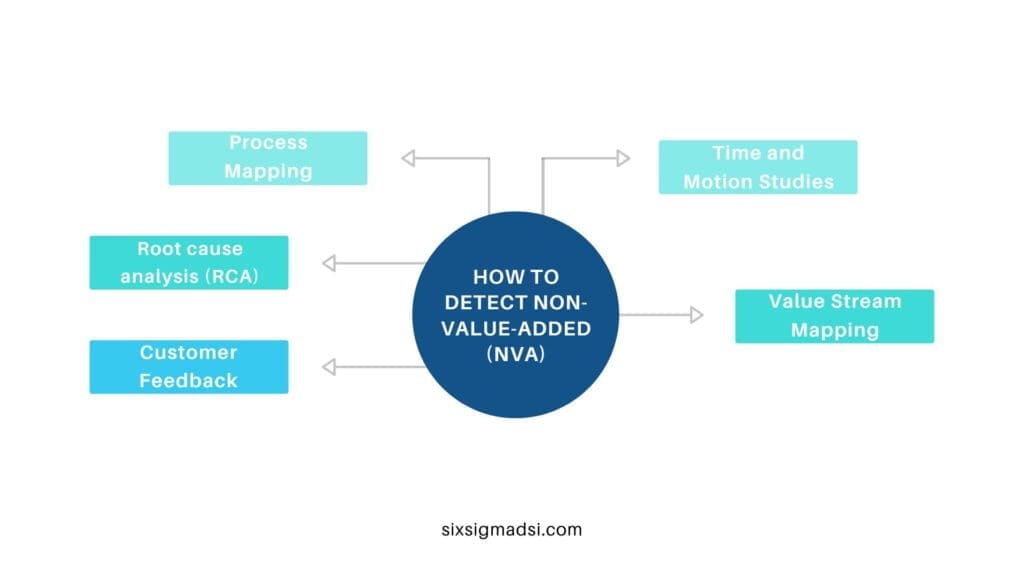Table of contents
Estimated reading time: 5 minutes
What is Non-Value-Added (NVA)?
In Six Sigma, Non-Value-Added (NVA) activities are activities or processes in a system that do not contribute to the production of a product or service and do not provide value to the customer. NVA activities consume resources and time but only result in a positive outcome for the customer or the organization.
Examples of NVA activities in a manufacturing process include:
- Waiting time: Time spent waiting for materials, equipment, or people to become available.
- Unnecessary motion: Excessive movement of people or equipment that does not contribute to the production of the product.
- Overproduction: Producing more products than is necessary to meet customer demand.
- Excess inventory: Holding more inventory than is necessary to meet customer demand.
- Defects: Products that do not meet customer specifications or are of poor quality.
- Unnecessary processing: Processing steps that do not contribute to the production of a product or service.
In Six Sigma, the goal is to identify and eliminate NVA activities in order to improve the overall process and increase efficiency. By reducing NVA activities, organizations can reduce costs, increase customer satisfaction, and improve their bottom line. The elimination of NVA activities is a key aspect of Six Sigma and Lean methodology, which focuses on continuous improvement and eliminating waste in processes.
How to Detect Non-Value-Added (NVA)

There are various methods for detecting Non-Value Added (NVA) activities in a process, including:
- Process Mapping: This involves creating a visual representation of a process to identify all steps involved and the flow of activities. It can help identify non-value-added activities (NVA) that are taking up resources without providing value to customers.
- Time and Motion Studies: This involves observing and measuring the time and motion involved in a process to identify areas for improvement. It can help identify NVA activities like waiting time, unnecessary motion, and defects.
- Root cause analysis (RCA): This involves identifying and eliminating the causes of problems within a process, so as to eliminate NVA activities that may be creating issues in the workflow.
- Value stream mapping: This involves creating a visual representation of the entire value stream for a product or service, from raw materials to customers. Doing this can help identify non-value-added activities (NVA) that do not add value to what the item or service ultimately offers.
- Customer Feedback: Gathering customer feedback about the quality and value of a product or service helps identify NVA activities that do not add value for customers, so they can be eliminated.
Six Sigma practitioners can utilize these methods to identify NVA activities and take steps to eliminate them to enhance the process and boost efficiency. Eliminating NVA activities is a cornerstone element of Six Sigma and Lean methodology, emphasizing continuous improvement and waste elimination from processes.
Benefits of Attending to Non-Value-Added
Attending to non-value-added activities and working to eliminate or improve them can provide several benefits for businesses. Here are some key advantages:
- Cost Reduction: Non-value-added activities often contribute to unnecessary costs in terms of time, resources, and materials. By identifying and eliminating these activities, businesses can reduce operational costs and improve overall financial performance.
- Increased Efficiency: Focusing on non-value-added activities helps streamline processes, reducing the time and effort required to deliver products or services. This increased efficiency can lead to faster production cycles, shorter lead times, and improved responsiveness to customer demands.
- Enhanced Customer Value: Eliminating non-value-added activities allows businesses to allocate resources more effectively toward activities that directly contribute to customer satisfaction. This can lead to the delivery of higher-quality products or services and improved customer experiences.
- Competitive Advantage: Lean and efficient operations can provide a competitive advantage in the marketplace. Companies that can produce goods or services more efficiently are often better positioned to offer competitive prices or innovative solutions, giving them an edge over competitors.
- Resource Optimization: Identifying and removing non-value-added activities helps optimize the use of resources, including manpower, machinery, and materials. This can lead to better resource allocation and utilization throughout the organization.
- Employee Engagement: Employees often find greater satisfaction in their work when they can contribute to meaningful tasks that add value. Streamlining processes and eliminating non-value-added activities can lead to more engaging and fulfilling work for employees.
- Improved Quality: By focusing on value-added activities, businesses can often enhance the quality of their products or services. This is because attention and resources are directed toward activities that directly impact the final output.
- Adaptability to Change: Lean practices, which involve continuous improvement and waste reduction, make organizations more adaptable to changes in market conditions, customer preferences, or regulatory requirements. This adaptability is crucial in today’s dynamic business environment.
- Environmental Impact: Streamlining processes and reducing waste often result in a smaller environmental footprint. This is increasingly important as businesses and consumers become more conscious of sustainability and environmental responsibility.
- Financial Performance: Ultimately, the benefits of attending to non-value-added activities contribute to improved financial performance. Cost reductions, increased efficiency, and enhanced customer value can positively impact the bottom line, leading to greater profitability.
In summary, addressing non-value-added activities is a strategic approach that can have far-reaching positive effects on various aspects of a business, ultimately contributing to its long-term success and sustainability.


















